Customer Retention Strategies That Lead to Higher Profits
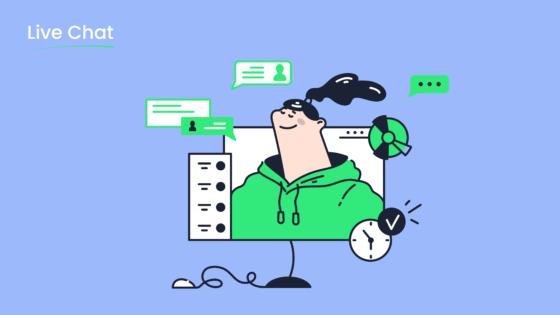
Effective customer retention strategies drive higher profits across industries. Research shows that increasing customer retention by just 5% can boost profits by up to 95% (Harvard Business Review). Loyal customers spend 67% more than new ones, and 65% of company revenue comes from existing customers. The advantages of customer retention include lower acquisition costs and stronger brand relationships. Sobot helps businesses achieve improved profitability through tools that enhance customer satisfaction and foster customer loyalty.
| Statistic Description | Impact on Profitability or Retention |
|---|---|
| Cost of acquiring a new customer is up to 5 times higher than retaining an existing one | Retention is more cost-effective |
| Companies prioritizing retention are 60% more profitable | Direct link to higher profits |
| Repeat customers spend 67% more than new customers | Loyal customers contribute more revenue |
| Increasing retention by 5% can increase profits by 25-95% | Small improvements yield large gains |
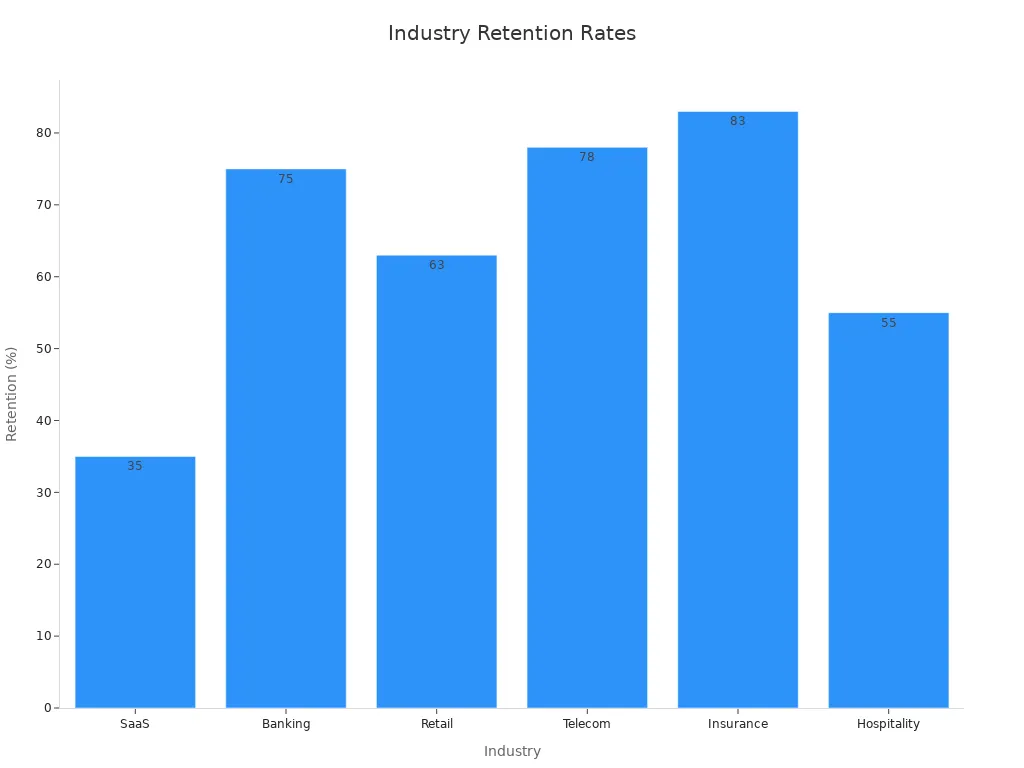
Customer Retention and Improved Profitability
Why Retention Matters
Customer retention stands at the core of improved profitability for any business. Companies that focus on keeping existing customers see predictable revenue streams and increased market share. Research from Bain & Company and Harvard Business Review shows that a 5% reduction in customer defection can increase profits by 25% to 95%. This dramatic impact comes from several factors:
- Retaining customers costs much less than acquiring new ones. Acquisition costs can be 5 to 25 times higher.
- The probability of selling to an existing customer is 60% to 70%, while selling to a new prospect is only 5% to 20%.
- Repeat customers spend 33% more than new customers.
- A 10% increase in retention can boost company value by 30%.
- 80% of future profits often come from just 20% of existing customers.
Companies that invest in boosting customer retention enjoy sustainable business growth, enhanced competitive positioning, and increased market share. Loyal customers require less marketing spend, generate valuable referrals, and contribute to predictable revenue streams. Sobot’s experience across industries demonstrates that businesses using Sobot Live Chat see higher customer lifetime value and improved profitability. For example, OPPO achieved a 57% increase in repurchase rate after implementing Sobot’s solutions, proving the direct link between retention and revenue growth.
Key Metrics and Impact
Measuring customer retention helps businesses understand how well they keep customers and how this affects revenue. Several key metrics provide insight into the connection between retention and profitability:
| Metric | Complexity & Resources | Link to Profitability Gains |
|---|---|---|
| Customer Retention Rate | Low complexity, basic data | Measures loyalty and business stability, correlates with revenue stability |
| Customer Churn Rate | Low-medium complexity | Identifies customer loss, enabling proactive retention efforts to protect revenue |
| Customer Lifetime Value | High complexity, predictive data | Predicts total revenue per customer, justifies retention investments |
| Net Promoter Score | Low complexity, survey-based | Indicates loyalty and referral potential, driving organic growth |
| Repeat Purchase Rate | Low complexity, transactional data | Tracks repeat buying, directly linked to increased sales and revenue |
| Customer Effort Score | Medium complexity, survey-based | Reduces friction, improves retention and loyalty, boosting profitability |
| Average Order Value | Low complexity, transactional data | Higher order values increase revenue per customer, enhancing profitability |
Customer retention rate and churn rate show how well a business retains customers and protects revenue. Customer lifetime value predicts the total revenue a customer will bring, guiding investment in retention strategies. Net Promoter Score measures loyalty and referral potential, which drives organic growth and increased market share. Repeat purchase rate and average order value track how often customers buy and how much they spend, both of which increase profitability. Customer Effort Score and Customer Satisfaction Score help identify ways to improve service and boost retention.
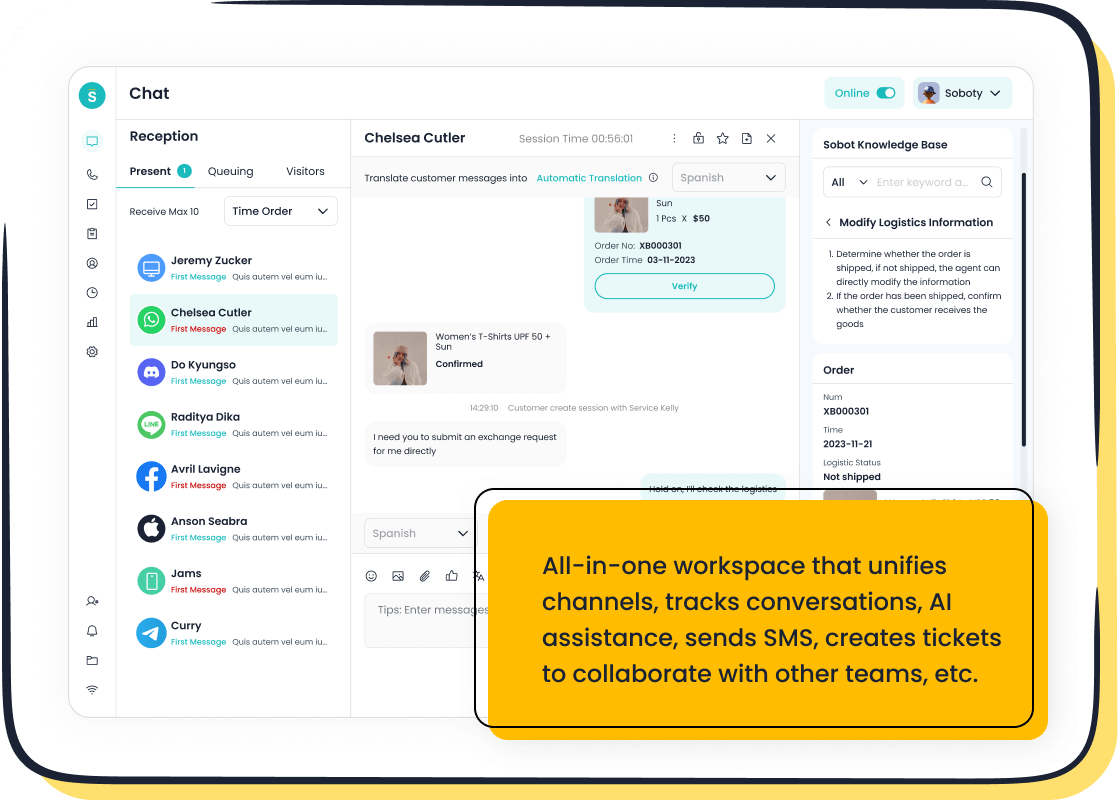
Sobot Live Chat supports these metrics by providing omnichannel support, AI-powered engagement, and real-time analytics. Businesses can track customer interactions, measure satisfaction, and identify opportunities to increase customer lifetime value. This data-driven approach leads to sustainable business growth, enhanced competitive positioning, and increased market share.
Advantages of Customer Retention
Customer retention offers a range of advantages that drive sustainable business growth. Companies that focus on keeping existing customers see measurable financial benefits, improved operational efficiency, and long-term value. The following table summarizes the main advantages of customer retention across business scenarios:
| Advantage Category | Supporting Evidence & Explanation |
|---|---|
| Financial Benefits | Increased revenue through higher customer lifetime value and repeat purchases. Existing customers spend about 67% more than new ones. Retained customers provide predictable revenue streams, which support strategic planning. |
| Cost Efficiency | Retention reduces marketing and acquisition costs. Acquiring new customers costs 5 to 25 times more than retaining existing ones. Loyal customers can be 22 times more valuable across sectors. |
| Operational Benefits | Better customer insights from feedback improve products and services. 77% of customers prefer brands that act on their feedback. Shortened sales cycles for existing customers due to trust. |
| Strategic Benefits | Sustainable business growth through a stable customer base. A 5% increase in retention can boost profits by 25-95%. Reduced vulnerability to market fluctuations. |
| Competitive Advantage | Differentiation through a customer-centric approach. Retention creates barriers to competitor entry by building strong customer relationships and loyalty. |
Cost Savings
Businesses experience significant cost savings by prioritizing customer retention. Acquiring a new customer costs up to 25 times more than keeping an existing one. Companies that invest in retention strategies reduce marketing expenses and increase the cost-effectiveness of retention. For example:
- 80% of future revenue comes from just 20% of existing customers.
- The probability of selling to an existing customer is 60-70%, compared to only 5-20% for new prospects.
- Repeat customers spend three times more than one-time shoppers.
Sobot Live Chat helps businesses maximize these savings by streamlining support and improving customer satisfaction.
Increased Revenue
Customer retention directly increases revenue. A 5% increase in retention can boost profits by 25% to 95% (Harvard Business Review). Companies that monitor customer lifetime value see higher returns from loyal customers. Early detection of spending drops allows businesses to intervene and prevent revenue loss. Positive word-of-mouth marketing from satisfied customers attracts new buyers and strengthens brand reputation. Sobot’s unified platform enables businesses to track customer lifetime value and optimize engagement for higher revenue.
Long-Term Value
The long-term value of customer retention lies in building a stable customer base that supports sustainable business growth. Retained customers contribute to predictable revenue streams through repeat purchases and upsells. Metrics such as customer retention rate, repeat purchase rate, and customer lifetime value help companies measure sustained benefits. High retention reduces vulnerability to market changes and allows more resources for innovation. Positive word-of-mouth marketing from loyal customers further enhances growth. Sobot’s solutions empower businesses to foster loyalty and achieve long-term financial benefits.
Building Customer Loyalty with Sobot
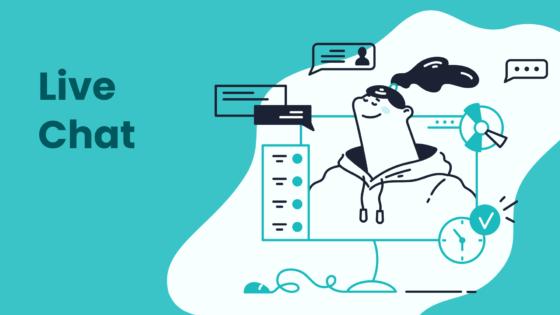
Personalized Engagement
Sobot Live Chat uses AI to deliver personalized engagement that drives customer loyalty and customer success. Businesses can tailor every interaction based on customer preferences, purchase history, and real-time behavior. For example, in retail, Sobot’s chatbots detect customer moods and suggest products that match their needs, leading to higher satisfaction and repeat business. In gaming, emotion-sensitive chatbots adjust gameplay tips, creating a more enjoyable experience. Healthcare providers use empathetic AI chatbots to schedule appointments and offer advice, building trust from the first contact.
| Company | Evidence of Personalized Engagement Impact on Customer Loyalty | Key Metrics / Outcomes |
|---|---|---|
| Alibaba | AI-driven personalized recommendations and chatbot support | 35% conversion lift; 20% increase in average order value |
| Vodafone | TOBi chatbot providing fast, accurate customer service | 70% first-time fix rate, leading to higher satisfaction and loyalty |
| H&M | AI-powered personalized engagement boosting sales | 15% sales increase |
74% of customers prefer chatbots for basic interactions, which improves satisfaction and builds a loyal customer base.
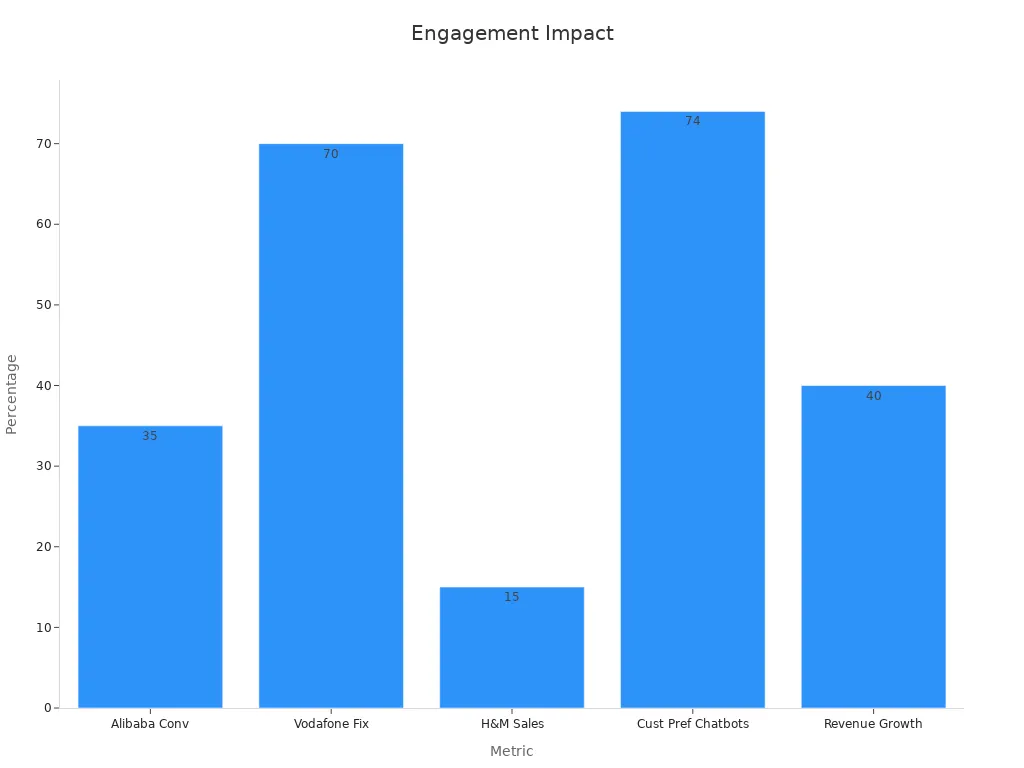
Omnichannel Support
Sobot’s omnichannel support ensures seamless customer engagement across websites, apps, WhatsApp, Facebook, and more. Companies with strong omnichannel strategies retain 89% of their customers, compared to only 33% for those with weak approaches (source). Brands using three or more channels see a 287% higher purchase rate. Sobot unifies all conversations, so agents never miss a message. This approach leads to enhanced customer loyalty, improved customer service, and positive word-of-mouth marketing. OPPO’s partnership with Sobot resulted in a 57% increase in repurchase rate, showing the power of omnichannel customer success.
Consistent Communication
Consistent communication forms the backbone of a strong customer relationship. Sobot centralizes customer data, standardizes templates, and automates follow-ups to ensure every message is timely and accurate. This process helps businesses understand customer needs, resolve problems quickly, and deliver improved customer service. Consistency builds trust, supports personalization, and creates a feedback loop for continuous improvement. As a result, companies see enhanced customer loyalty, more positive word-of-mouth marketing, and higher customer engagement.
Enhancing Customer Satisfaction
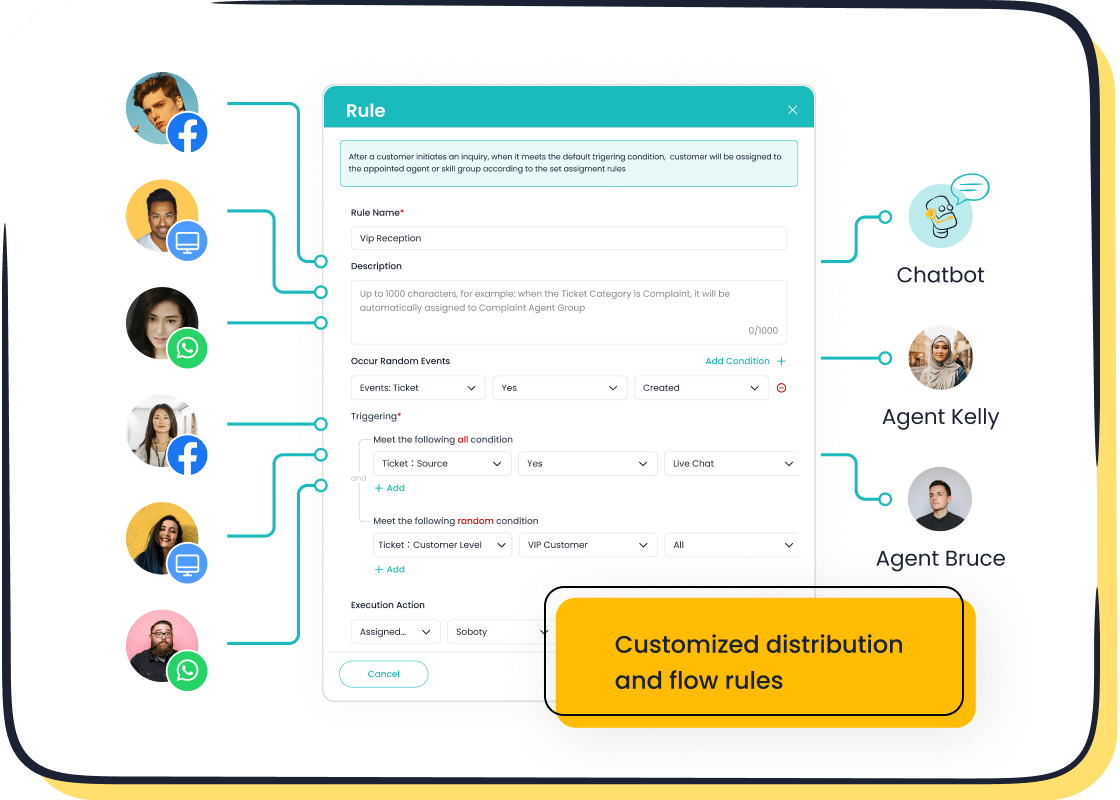
Fast Response Times
Fast response times play a crucial role in customer satisfaction. Customers expect quick answers when they reach out for help. Studies show that 50% of customers find any wait longer than five minutes unacceptable. Only 2% consider a 10-minute wait reasonable, yet many companies report average wait times of 10 minutes. Quick replies not only improve customer satisfaction but also drive customer success and loyalty.
- 34% of customers say fast responses are the top benefit of self-service support.
- 54% value first contact resolution even more than speed or professionalism.
- A regression analysis found a strong link between shorter response times and higher customer satisfaction (beta parameter: 0.593).
- 59% of customers are more likely to buy when brands respond in under one minute.
Key metrics like First Response Time (FRT) and Average Resolution Time (ART) help businesses measure and improve their service. Sobot Live Chat enables agents to reply instantly across channels, reducing FRT and boosting customer satisfaction. Companies that monitor these metrics see higher customer success rates and improved customer service.
Proactive Support
Proactive support means reaching out to customers before they ask for help. This approach increases customer satisfaction and builds trust. Companies that offer proactive support see a 95% improvement in retention rates. 77% of consumers appreciate brands that solve issues before they become problems. Businesses that improve contact center performance increase retention by 80%. High customer satisfaction leads to 21% more repeat business, and 73% of companies link satisfaction directly to revenue.
| Statistic Description | Percentage/Value |
|---|---|
| Proactive customer service efforts improve retention rates | 95% |
| Consumers who appreciate brands that proactively solve issues | 77% |
| Companies improving contact center performance increase retention | 80% |
| Companies with high customer satisfaction see more repeat business | 21% more |
| Companies linking customer satisfaction directly to revenue | 73% |

Sobot’s AI-powered tools help businesses identify issues early and offer solutions, ensuring customer success and improved customer service.
Feedback and Improvement
Customer feedback drives continuous improvement and higher customer satisfaction. Companies gather feedback through surveys, reviews, and direct communication. They analyze this input to spot trends and address concerns. Constructive feedback leads to better performance, proactive skill development, and stronger customer relationships.
- Direct feedback gives actionable insights for service upgrades.
- Indirect feedback from social media reveals customer attitudes.
- Regular analysis helps prioritize improvements.
- Closing the feedback loop by acting on suggestions builds trust.
Real-world examples show the power of feedback. Amazon launched Prime after hearing about shipping delays. Starbucks improved its app and in-store experience based on customer requests. Sobot’s unified platform makes it easy to collect, analyze, and act on feedback, supporting customer engagement and customer success.
Measuring Customer Retention Success
Retention Rate Calculation
Companies measure customer retention by tracking how many customers stay over a set period. The most common formula is:
CRR = (Number of customers at end of period – Number of new customers acquired) / Number of customers at start of period × 100
For example, if a business starts with 500 customers, gains 150 new ones, and ends with 600, the retention rate is [(600 – 150) / 500] × 100 = 90%. This means the company managed to retain customers at a high level. Strong retention rates often range from 70% to 90%, depending on the industry. Businesses in banking or entertainment usually see higher rates, while retail and hospitality may face more challenges.
| Industry | Average Retention Rate | Key Success Factors |
|---|---|---|
| Banking & Financial | 75% | Personalized service, trust |
| Media & Entertainment | 84% | Engaging experience, community |
| Retail & E-commerce | 63% | Loyalty programs, offers |
| Hospitality & Travel | 55% | Unique experiences, service |
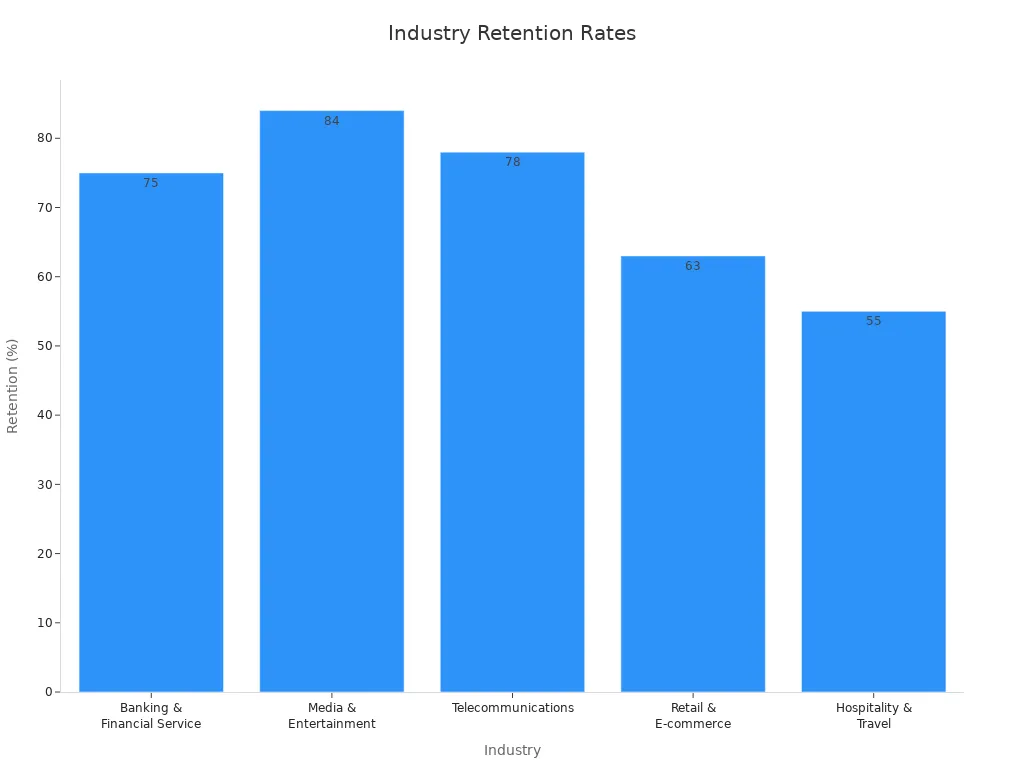
Analyzing Customer Feedback
Customer feedback gives better customer insights and helps companies understand why people stay or leave. Businesses use surveys like Net Promoter Score (NPS) and Customer Satisfaction Score (CSAT) to measure loyalty and satisfaction. Regular feedback collection highlights pain points and reveals what customers value most. For instance, ShopSmart improved retention by 28% after acting on feedback and adjusting its processes. Companies also use analytics tools to turn feedback into better customer insights, which leads to higher customer lifetime value and more revenue.
| Evidence Type | Description | Impact |
|---|---|---|
| NPS & CSAT Surveys | Measure loyalty and satisfaction | Key retention metrics |
| Feedback Analytics | Identify pain points and trends | 25-30% retention increase |
| Case Study | ShopSmart improved retention with feedback loops | 28% retention improvement |
Optimizing Strategies
To optimize customer retention, companies set clear goals and track key metrics like customer lifetime value, repeat purchase rate, and churn rate. They invest in CRM and analytics tools to gain better customer insights and train teams to act on data. Regular reviews of retention metrics help businesses adjust strategies quickly. Industry benchmarks guide improvements, while feedback ensures strategies match customer needs. Companies that use data-driven approaches see more revenue and higher customer lifetime value. Sobot’s unified platform supports these efforts by centralizing data and making it easier to retain customers.
| Step | Action Item |
|---|---|
| Set KPIs | Define retention, revenue, and value goals |
| Use Analytics | Track and analyze customer behavior |
| Train Teams | Teach importance of retention and measurement |
| Review & Adjust | Regularly update strategies based on insights |
| Collaborate | Align departments for unified retention efforts |
Continuous improvement, guided by better customer insights and industry benchmarks, helps companies maximize revenue and customer lifetime value.
Customer retention strategies drive long-term profit and business growth. Companies that focus on customer loyalty, customer satisfaction, and customer engagement see higher revenue and lower costs. The table below highlights the direct impact of retention on profitability:
| Metric | Impact on Profitability and Business Performance |
|---|---|
| Customer Retention Increase | A 5% increase in retention can boost profits by 25% to 95%, with Bain & Company reporting up to 75% profit increase. |
| Customer Lifetime Value (CLV) | Retention increases CLV as customers stay longer and purchase more, driving sustainable revenue growth. |
| Customer Acquisition Cost (CAC) | Retaining customers reduces CAC significantly, as acquiring new customers can cost 5 to 25 times more than retention efforts. |
| Customer Churn Rate | Reducing churn through retention strategies can increase revenues by up to 15%, according to McKinsey. |
| Upselling and Cross-Selling | Retained customers have a 60-70% success rate for upselling, compared to 5-20% for new customers, boosting revenue by 10-30%. |
| Net Promoter Score (NPS) | Higher retention correlates with higher NPS, which can double company growth through increased customer advocacy and loyalty. |
Sobot Live Chat helps businesses build strong relationships and measure results. Companies should try at least one new strategy and track its impact. Explore Sobot’s solutions to improve retention and drive sustainable success.
FAQ
What is customer retention and why does it matter?
Customer retention means keeping existing customers over time. High customer retention leads to more revenue and lower costs. Studies show a 5% increase in retention can boost profits by up to 95% (source). Sobot helps companies improve customer retention with advanced engagement tools.
How does customer loyalty impact business growth?
Customer loyalty drives repeat purchases and referrals. Loyal customers spend 67% more than new ones. Businesses with strong customer loyalty see higher customer satisfaction and customer success. Sobot’s omnichannel solutions help brands build loyalty through consistent communication and personalized engagement.
What role does customer satisfaction play in retention?
Customer satisfaction encourages customers to stay and buy again. Satisfied customers are more likely to recommend a brand, increasing customer engagement. Sobot Live Chat enables fast responses and proactive support, which boosts customer satisfaction and customer retention.
How can companies measure customer engagement effectively?
Companies track customer engagement using metrics like Net Promoter Score, repeat purchase rate, and feedback surveys. Sobot’s analytics dashboard provides real-time insights, helping businesses understand customer engagement and improve customer success strategies.
What makes Sobot effective for customer success?
Sobot offers AI-powered chat, omnichannel support, and real-time analytics. These features help businesses increase customer retention, customer loyalty, and customer satisfaction. OPPO, for example, saw a 57% rise in repurchase rate after using Sobot’s solutions for customer engagement and support.
See Also
Top Strategies To Enhance Customer Satisfaction Through Live Chat
How To Excel At Live Chat Within Retail Businesses
Effective Live Chat Techniques To Improve SaaS Customer Support
Around The Clock Live Chat Drives Greater Business Growth
Ways Ecommerce Live Chat Tools Increase Online Sales Revenue
